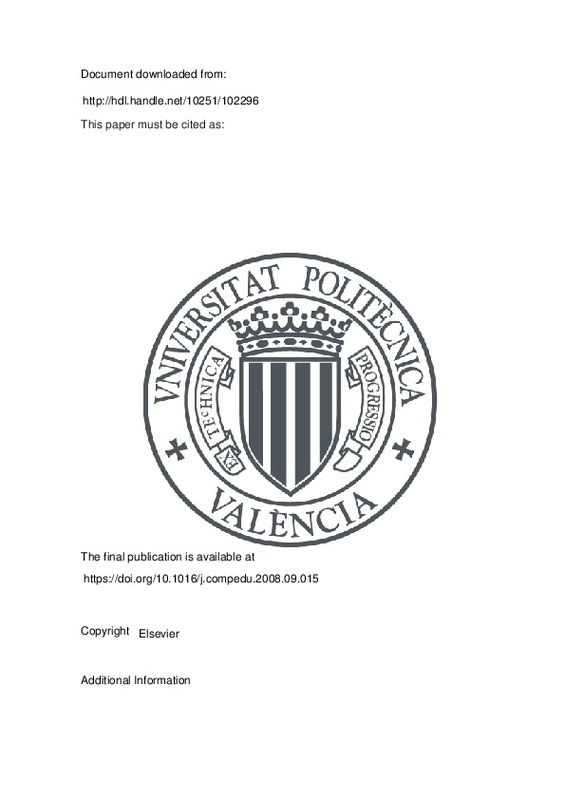JavaScript is disabled for your browser. Some features of this site may not work without it.
Buscar en RiuNet
Listar
Mi cuenta
Estadísticas
Ayuda RiuNet
Admin. UPV
Learning the attachment theory with the CM-ED concept map editor
Mostrar el registro sencillo del ítem
Ficheros en el ítem
| dc.contributor.author | Rueda Molina, Urko
|
es_ES |
| dc.contributor.author | Arruarte, Ana
|
es_ES |
| dc.contributor.author | Elorriaga, Jon Ander
|
es_ES |
| dc.contributor.author | Herrán, Elena
|
es_ES |
| dc.date.accessioned | 2018-05-20T04:22:39Z | |
| dc.date.available | 2018-05-20T04:22:39Z | |
| dc.date.issued | 2009 | es_ES |
| dc.identifier.issn | 0360-1315 | es_ES |
| dc.identifier.uri | http://hdl.handle.net/10251/102296 | |
| dc.description.abstract | [EN] This paper presents a study carried out at the University of the Basque Country UPV/EHU with the aim of evaluating the CM-ED (concept map editor) with social education students. Concept mapping is a widely accepted technique that promotes meaningful learning. Graphically representing concepts of the learning domain and relationships between them helps students integrate new knowledge into their current cognitive structure. Due to the flexibility of computer-aided drawing graphs, several concept mapping tools have been developed and their use has been studied over the last few years. CM-ED is a multilingual and multimedia software program designed for drawing concept maps. Until recently, CM-ED had been mainly used and evaluated in computer science university degree. This paper represents a qualitative step in the evaluation of CM-ED: from technical students to students of more theoretical fields. The main characteristics of the CM-ED editor and the carried out study are presented in this paper. | es_ES |
| dc.description.sponsorship | This work is supported by the University of the Basque Country UPV/EHU (UE06/19), the MEC (TIN2006-14968-C02-01) and the Gipuzkoa Council in an EU Program. | es_ES |
| dc.language | Inglés | es_ES |
| dc.publisher | Elsevier | es_ES |
| dc.relation.ispartof | Computers & Education | es_ES |
| dc.rights | Reserva de todos los derechos | es_ES |
| dc.subject | Concept maps | es_ES |
| dc.subject | Concept map editor | es_ES |
| dc.subject | Evaluation of CAL systems | es_ES |
| dc.subject | Improving classroom teaching | es_ES |
| dc.subject | Post-secondary education | es_ES |
| dc.title | Learning the attachment theory with the CM-ED concept map editor | es_ES |
| dc.type | Artículo | es_ES |
| dc.identifier.doi | 10.1016/i.compedu.2008.09.015 | es_ES |
| dc.relation.projectID | info:eu-repo/grantAgreement/MEC//TIN2006-14968-C02-01/ES/AYUDA AL APRENDIZAJE EN ENTORNOS DE REALIDAD VIRTUAL/ | es_ES |
| dc.relation.projectID | info:eu-repo/grantAgreement/UPV%2FEHU//UE06%2F19/ | es_ES |
| dc.rights.accessRights | Abierto | es_ES |
| dc.description.bibliographicCitation | Rueda Molina, U.; Arruarte, A.; Elorriaga, JA.; Herrán, E. (2009). Learning the attachment theory with the CM-ED concept map editor. Computers & Education. 52(2):460-469. https://doi.org/10.1016/i.compedu.2008.09.015 | es_ES |
| dc.description.accrualMethod | S | es_ES |
| dc.relation.publisherversion | https://doi.org/10.1016/j.compedu.2008.09.015 | es_ES |
| dc.description.upvformatpinicio | 460 | es_ES |
| dc.description.upvformatpfin | 469 | es_ES |
| dc.type.version | info:eu-repo/semantics/publishedVersion | es_ES |
| dc.description.volume | 52 | es_ES |
| dc.description.issue | 2 | es_ES |
| dc.relation.pasarela | S\38002 | es_ES |
| dc.contributor.funder | Ministerio de Educación y Ciencia | es_ES |
| dc.contributor.funder | Universidad del País Vasco/Euskal Herriko Unibertsitatea | es_ES |
| dc.contributor.funder | Diputación Foral de Gipuzkoa | es_ES |







![[Cerrado]](/themes/UPV/images/candado.png)

